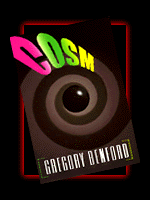I began working on the novel in the late 1980s, spurred not by a character or a plot, but by papers published in the best physics journals by Alan Guth and collaborators. If this seems a dry way to begin, bear with me.

Alan was already famous, having constructed in the early 1980s a truly amazing new theory of our universe. I commend to you his excellent account of his invention, The Inflationary Universe. According to the inflationary model of cosmology, our universe grew out of less than ten kilograms starting in a region 10-24 cm across. One could hold such an object in one hand.
More recently, Guth and his co-workers have made intricate calculations of the physics of universe-creation -- in the laboratory! This suggested a large theme, suitable to fictional treatment.
While I was at M.I.T. on sabbatical leave, I enjoyed many delightful conversations with Alan Guth, whom I had met some years before. Ideas came readily, and I roughed out a plan for this novel. A visit to the Brookhaven National Laboratory helped this germination along, as did walking through "RHIC," the Relativistic Heavy Ion Collider under construction.
The enormous, impressive accelerator building there suggested to me a possible way that some of the ideas developed in those M.I.T. papers might find expression in our time. Could the tiny, compressed collisions of the RHIC cash in on the chance to imitate the first instant of our universe, and make another?
Ah, I thought, but what would happen to such an exotic accidental offspring? It would depend upon compact mass digging a hole in its own space-time, making our "true vacuum" form a "false vacuum" which then became a "child universe." What would happen then lies beyond the realm of computable theory.
Of course, the entire matter is a huge long shot. One must consider that energies available at a facility like RHIC are relatively puny compared with the energy densities of the very early universe. Only if quantum mechanics works just right will a child universe be spawned. We do not in fact know how to do the calculation. A correct one awaits a better understanding. Further, there are the great uncertainties of our current rickety ideas about what a better, true theory of quantum gravity might look like. It could well be that a solid theory will rule out everything envisioned in this novel.
Still, such ideas stir the imagination. In planning and writing this book I had what seemed a good notion for rounding out the book's conceptual framework, but who was my lead character? Why not have some further fun with a black woman physicist -- and put her in my own physics department at the University of California, Irvine? I could depict in thinly veiled fashion real people, make indirect comments on the life of a professor. It could be delicious, not too dry, maybe even allow a dollop of wit here and there. A sort of tighter, faster version of Timescape, my most popular novel.
I like audacious ideas, and this novel taps them in another important context: the world of scientists as they actually are, especially at work. Except for detectives and spies, seldom does fiction spend much time treating people at their work, yet it is a central aspect of life.
I hope along with some intellectual excitement, I have made some aspects of the scientific enterprise and those who carry it forward at least a bit more understandable. All foreground characters are entirely invented. I have used the names of several actual people as background figures, for a note of authenticity. But whether this book works for a reader depends on how human the characters seem, seen against their daunting works. I hope mine have enough dimension to propel a reader on.

